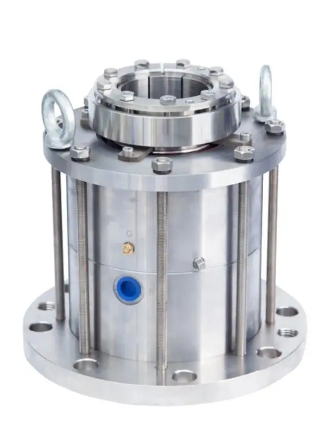Tushunish agitator muhri Mekhanik va Tiklanish Asoslari
Qanday qilib Agitator muhrlari Ish: Asosiy komponentlar va funksiyalar
Agitator muhrlari muammolar yuzaga chiqishidan oldin suv yoki sodda gaz talab etilgan bosimda saqlashga yordam beradi va turli loyihalarda ishlab chiqarishni osonlashtiradi. Ushbu sig‘atlar bir nechta asosiy komponentlardan iborat bo‘ladi, masalan, sig‘at yuzaqlari, spring mekhanizmlari va uy, barchasi bir-biriga bog‘langan holda suv yoki sodda gaz talab etilgan joydan chiqishi oldidan oldini oladi. Har bir komponentning umumiy operatsiya bilan qanday bog‘liq ekanligini tushunish, muammo chegaralarni aniqlash va hal qilishni osonlashtiradi.
Агитатор ўрниқи йўналишининг усулли келиб чиқадиган сабаблари
Агитатор ўрниқи йўналишига бир necha фактор илова етиши мумкин, энг мулоҳазалиси химийавий таъсирдан ва механикаviy туг‘йондандан берилган материалдаги деградация. Муҳит шартлари, маисалда температура озгарishi, ўрниқning ҳажмий жараёнини ва функцсиюларини кatta аҳамиятга эга. Шунингdek, нотоғри суслик орнатиш масаласи ўрниқ ишлатишда ўзgarishga иборат масалалар цепи бoshланг'ичsini ишлатишга туслашади. Ушбу усулли сабабларни танишув бизга тақиқатли сурошув таъминоти ўтказишга va ваqtинча алмаштиришга ва ўрниқларning жами давомети вақтини кеширишга рухсат беради.
Ози-ози ўрниқ алыб алмаштириш учун муҳим асбоблар
Алыб алмаштириш agitator muhrlari ma'lum bir asboblar to'plami talab qilinadi, bu esa to'liq va effektiv jarayonni ta'minlaydi. Asosiy narsalar screwdrivers (vintchiluvchi asboblar), wrenches (muqavva), seal pullers (yopiq olib tashlash uchun asboblar) va yopiqlarni o'rnatish talablari uchun mos keladigan smazochniki (yuqoringiz). To'g'ri asboblardan foydalanish faqat o'zgartirish jarayonini osonlashtiradi balki keyingi muammolardan ximoya qiladi. Ushbu asboblarni tanlashda ularning sifati va yopiq turlari bilan uyumliligiga e'tibor bering, tarmoqlash jarayonida avvalroq muammolar yuz berishi mumkin emasligini ta'minlash uchun.
Agitator Yopiq Almashtirish Jarayoni Bo'yicha Qadamlar
Ish Joyingizni Tayyorlash va Unitni Ajratish
Agitator sig'imi yozuvini almashtirish jarayonini muvaffaqiyatli bajarish uchun, avval oson va tartiblangan ish joyini tayyorlash zarur. Ushbu tayyorlik effektiv jarayonni ta'minlaydi va operatsiya davom etishiga qaramasdan komponentlarni pozilish riskini kamaytiradi. Men har doim disassemble jarayonining har bir qadamyani hujjatlarga olishni taklif qilaman. Aniq olib tashlash qadamlarini suratga olish yoki yozib qoldirish reassembly davomida qiymatli bo'ladi. To'g'ri tartibni unutish oson bo'lib, bu jihatlarda xatoliklar va murakkabliklar sabab bo'lishi mumkin.
Xavfsizlik hamma narsadan oldin eng muhim hissadir. Unitga qarashli barcha energiya manbalarni alohida qiling va oquvchi urinishlarni oldini olish uchun qorovul honalar va xavfsizlik steklolari kabi himoyalangan turli asboblardan foydalaning. Ushbu ehtiyojlar siz uchun xavfsiz ish joyi yaratadi va musibatlarning yuz berish ehtimollarini ko'paytiradi.
Ayolangan sig'imni olib tashlash: eng yaxshi amallar
Ярмоқ топишмаси ўчиб кетгани жаҳатда, унга яқин бўлган бoshqa бирнече компонентларга зиян бермаслик учун низомли қадамлар орнатилishi лозим. Ушбу жараёнда энг й axлий практикалардан фойдаланиш мухим. Мен сизга ярмоқ топишмасини чекиш учун маҳсус асбоблардан, мисол учун, ярмоқ чейиқларидан фойдаланиш ва янги давлардан фойдаланишни таклиф этман. Бу кампания хонасини босқилишга тушкунчалик ташлаш учун керакли етма-етмасликларга ишонч кўрамиз.
Ярмоқ топишмаси муваффақият билан ташлангандан сўнг, унинг туғри равишда тозалаб ташланishi жараёнда тоза иш жойи саqlash ва контаминациядан кутариш учун маҳмуридир. Ярмоқ топишмаси кеchиканувчи практикаларidan фойдаланиш эски ярмоқ топишмаси янги ярмоқ топишмаси орнашида ташланадиган таьсирини камчилишга ёрдам беради.
Янги ярмоқ топишмасини орнатиш: Чизиш ва позициялаш ёнда сарорий саводлар
Yangi sigilni o'rnatish uchun uning doimiy ishlatilishini ta'minlash uchun zamonaviy to'qirqatish zarur. O'rnatish jarayonida to'g'ri rivojlantirish talab qilinadi, chunki bu yotishlarni oldash va sigilning doimiy ishlashiga yordam beradi. Men har doim ishlab chiquvchi firmaning o'rnatishda yordam beradigan qo'llanmasiga amal qilgan holda sigilni to'g'ri joylashtiramiz.
Sigilni joylashtirishdan oldin, mos keluvchi yoroshliqlarni qo'llash, friktatsiya muammolarini kamaytirish va jarayonni eng yaxshisi bilan amalga oshirishga yordam berishi mumkin. O'rnatilganidan so'ng post-o'rnatish tekshiruvi aniq hisoblanadi. Bu tekshiruvlar sigilning hech qanday bo'sh joy qolmagan holatda to'g'ri joylashganligini tasdiqlaydi, uni yaxshi ravishda bog'langanligiga ishonch hosil qiladi va keyingi xatosini oldini oladi. Shunday qilib, sigilning ishonchli ishlashiga rivojlantirish va joylashish jarayonida katta ahamiyat beriladi.
Ushbu bo'limda amaliyotda paydo bo'ladigan umumiy muammolar bilan bog'liq masalalar yechimi haqida gapiraman.
O'rnatishdagi xatolarni aniqlash va to'g'rilash
Yangi mixayotchi yopqinisini o'rnatgandan so'ng, suzilish yoki noto'g'ri joylashuvdan sabab topshirgan holda yoyilishlarni tekshirish muhim. Bunday xatolar obodajon qurilma ishlashida qandaydir noyob holatlarda eshitiladigan ovozlar yoki titrilmalar ko'rinishida ifodalanadi. Shu simptomlar yopqinin o'rnatilishi bilan bog'liq muammolarning borligini bildiruvchi ogohlantirish hisoblanadi. Ushbu muammolarni vaqtinchalik hal qilish, jihatidan qurilma ishlamay qolishidan oldin va uning ishlaydigan davri uzatish uchun zarur. To'liq post-o'rnatish tekshiruvini amalga oshirsa bo'ladi, yopqining to'g'ri ravishda o'rnatilgan va efektdor ravishda vazifasini bajarayotganiga isbot bo'ladi. Bu proaktiv yo'ldorlik yondashuv qiymat berilgan vaqtni va resurslarni kamaytirish orqali to'xtash va kutilmagan tuzatmalarni kamaytiradi.
Qayta qaytariladigan yoyilishlarni va performans muammolarini hal qilish
Agitator sig‘imini almashtirgandan so‘ngra davom etuvchi talqinlar yuzaga kelgan bo‘lsa, bu sig‘imning ishlamayishi yoki tezda hal qilish kerak bo‘lgan o‘rnatish muammosi ekanligini ko‘rsatishi mumkin. Operatsion bosim va temperatur kabi omillarni tekshirish muhim, chunki ular sig‘im ishlanmasiga aniqaroq ta’sir yetkazadi. Mасhul oil yoki soch qadamlaridagi o‘zgarishlarni tekshirish kabi sistemli muammolarni aniqlash usuli orqali muammo asosiy sabablarini tezda topish mumkin. Ushbu muammolar bilan tezda urinib chiqish va ularni hal qilish orqali siz texnikangizning ishonchli va efektiligini oshirishingiz mumkin, shuningdek e’tiborsiz talqindan keyin yuzaga kelishi mumkin bo‘lgan boshqa muammolardan oldincha saqlashingiz ham mumkin.
Uzoq muddatlik sig‘im ishlashining muhofaza strategiyasi
Regulyar to‘xum ro‘yxati uchun Agitator muhrlari
Vaqt davomida mixora qopqalarining butunligini va ishlash qabiliyatini saqlashda muhayyer to'g'ri tartiblangan tekshiruv chek-listining amalga oshirilishi asosiy hissa bo'ladi. Qopqalar holatini regulyar ravishda kuzatib chiqish, istirok va sharm bilan bog'liq oldindagi belgilarni aniqlashga yordam beradi va nonastik avariyalarni oldini olishga imkon beradi. Tekshiruvdagi asosiy omillar ichimlik sutterishlarini tekshirish, qopqa butunligini tasdiqlash va muhit sharoitlarini baholash qilinadi. Ushbu tekshiruv protokollariga muvofiq harakat etish orqali faqat qopqalarning hayotiy davrlarini uzaytirish mumkin emas, balki umumiy texnika ishlab chiqarishining qabul qilinadigan holatini saqlash ham mumkin. Bu muvaffaqiyatli turdagi muhandislik strategiya sifatida operatsion avvalgi avtomatlashtirishni kamaytirish uchun asoslanadi.
Istirokni oldini olish uchun rivojlantirish va tozalash usullari
Масалар ва қўйиш техникалари турли хато ва жара тагидалардан босиш учун муҳимdir. Масаларнинг туғри турини аниқлаш ва унинг фрекцуювчиликка сабаб болган нуқталарini камaytirish мумkin. Тозалаш техникалари, масалан, туғри солвентлардан фойдаланиш орқали таъминотларда муаммоларга сабаб бўлмайди. Бирор процесслар учун қайси масала ёки тозалаш материаллари керак эканлигини тушуниш беттарда бошка хусусиятлар беради. Ушбу практикalar турли хато ва жара тагидалардан босиш учун муҳимdir.
Ko'p so'raladigan savollar
Агитатор таъминотлари нимадир ва улар нимадир?
Агитатор таъминотлари тузилмаларда тиккучлик ва босимни сақлаш учун критикалидир. Улар операцияларни чангат ва тезликда амалга оширишга ёрдам беради.
Агитатор таъминотларини алмаштириш учун қандай асбоблар лозим?
Tayanch asboblar tayyorligi uchun kerakli asboblar: vintka, g'ildirklar, tayanch chiqarish uskunalari va muvaffaqiyatli o'rnatish uchun maxsus tuvallaqlar.
Kerakli tayanch xatosini oldini olishim mumkinmi?
Tayanch xatosini oldini olish shunday umumiy sabablar bilan tanishib chiqishga, masalan, kimyoviy ta'sir va mekhanikaviy yuk, oldindan saqlashni amalga oshirish va to'g'ri o'rnatishga e'tibor bermasdan iborat.
Yangi tayanch o'rnatilganidan so'ng suzilish bo'lsa qanday ish qilishim kerak?
Agar tayanch almashtirilgandan so'ng suzilish paydo bo'lsa, noto'g'ri mos kelish, noto'g'ri joylashtirish va misollar ko'rsatilgan ishlash sharoitlari, masalan, bosim va haroratni yechim uchun tekshiring.
Mundarija
-
Tushunish agitator muhri Mekhanik va Tiklanish Asoslari
- Qanday qilib Agitator muhrlari Ish: Asosiy komponentlar va funksiyalar
- Агитатор ўрниқи йўналишининг усулли келиб чиқадиган сабаблари
- Ози-ози ўрниқ алыб алмаштириш учун муҳим асбоблар
- Agitator Yopiq Almashtirish Jarayoni Bo'yicha Qadamlar
- Ish Joyingizni Tayyorlash va Unitni Ajratish
- Ayolangan sig'imni olib tashlash: eng yaxshi amallar
- Янги ярмоқ топишмасини орнатиш: Чизиш ва позициялаш ёнда сарорий саводлар
- Ushbu bo'limda amaliyotda paydo bo'ladigan umumiy muammolar bilan bog'liq masalalar yechimi haqida gapiraman.
- O'rnatishdagi xatolarni aniqlash va to'g'rilash
- Qayta qaytariladigan yoyilishlarni va performans muammolarini hal qilish
- Uzoq muddatlik sig‘im ishlashining muhofaza strategiyasi
- Regulyar to‘xum ro‘yxati uchun Agitator muhrlari
- Istirokni oldini olish uchun rivojlantirish va tozalash usullari
- Ko'p so'raladigan savollar


